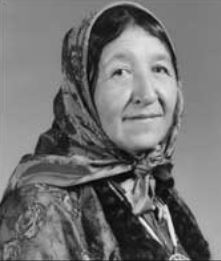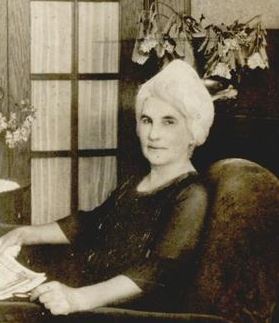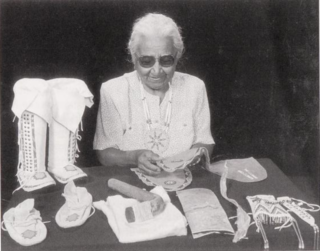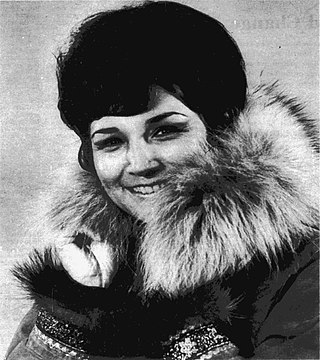Related Research Articles

Interstate 40 (I-40) is a major east–west transcontinental Interstate Highway in the southeastern and southwestern portions of the United States. At a length of 2,556.61 miles (4,114.46 km), it is the third-longest Interstate Highway in the country, after I-90 and I-80. From west to east, it passes through California, Arizona, New Mexico, Texas, Oklahoma, Arkansas, Tennessee, and North Carolina. Its western end is at I-15 in Barstow, California, while its eastern end is at a concurrency with U.S. Route 117 (US 117) and North Carolina Highway 132 (NC 132) in Wilmington, North Carolina. Major cities served by the interstate include Flagstaff, Arizona; Albuquerque, New Mexico; Amarillo, Texas; Oklahoma City, Oklahoma; Little Rock, Arkansas; Memphis, Nashville, and Knoxville in Tennessee; and Asheville, Winston-Salem, Greensboro, Durham, Raleigh, and Wilmington in North Carolina.
Muriel Hazel Wright was an American teacher, historian and writer on the Choctaw Nation. A native of Indian Territory, she was the daughter of mixed-blood Choctaw physician Eliphalet Wright and the granddaughter of the Choctaw chief Allen Wright. She wrote several books about Oklahoma and was unofficially called "Historian of Oklahoma". She also was very active in the Oklahoma Historical Society and served as editor of the Chronicles of Oklahoma from 1955 to 1971.

Susie Peters was an American preservationist and matron at the Anadarko Agency, who worked to promote Kiowa artists. Born to white parents in Tennessee, she moved to Indian Territory with her family prior to Oklahoma statehood. While working as a matron for the Indian Agency, she discovered the talent of the young artists who would become known as the Kiowa Six and introduced them to Oscar Jacobson, director of the University of Oklahoma's art department. She was honored by the National Hall of Fame for Famous American Indians and both adopted by the tribe and given a Kiowa name in 1954. In 1963, the Anadarko Philomathic Club created an annual art award in her name. She was inducted into the Oklahoma Women's Hall of Fame in its inaugural year, 1982.

Alice E. Brown was a member of the Kenaitze Tribe of Dena'ina peoples, who worked for Native Alaskan rights. She was the only woman to serve on the original Alaska Federation of Natives' Board of Directors and pressed for passage of the Alaska Native Claims Settlement Act. Brown was posthumously inducted into the Alaska Women's Hall of Fame in 2010.

Marie C. Cox (1920-2005) was a Comanche activist who worked on legislation for Native American children. She received many accolades for her efforts including the 1974 Indian Leadership Award from the Bureau of Indian Affairs and state recognition that same year as the Outstanding Citizen of Oklahoma from Governor David Hall. She was named as an Outstanding Indian Woman of 1977 by the North American Indian Women's Association, and served on the National Advisory Council on Indian Education from 1983 to 1990. In 1993, she was inducted into the Oklahoma Women's Hall of Fame for her work with foster children and the founding of the North American Indian Women's Association.

Susie Walking Bear Yellowtail (1903–1981) (Crow-Sioux) was the first Crow and one of the first Native Americans to graduate as a registered nurse in the United States. Working for the Indian Health Service, she brought modern health care to her people and traveled throughout the U.S. to assess care given to indigenous people for the Public Health Service. Yellowtail served on many national health organizations and received many honors for her work, including the President's Award for Outstanding Nursing Health Care in 1962 and being honored in 1978 as the "Grandmother of American Indian Nurses" by the American Indian Nurses Association. She was inducted into the Montana Hall of Fame in 1987 and in 2002 became the first Native American inductee of the American Nurses Association Hall of Fame.

Estelle Chisholm Ward was an Oklahoma teacher, journalist and magazine publisher. She was active in politics both civic and tribal and was elected as county treasurer of Johnston County, Oklahoma. Ward was the first woman to represent the Chickasaw Nation as a delegate to Washington, D.C.
The 1969 NCAA College Division football rankings are from the United Press International poll of College Division head coaches and from the Associated Press. The 1969 NCAA College Division football season was the 12th year UPI published a Coaches Poll in what was termed the "Small College" division. It was the tenth year for the AP version of the Small College poll.
Vera Brown Starr was the first woman elected as chair of the Yavapai-Apache Nation and served two years in the office, as well as serving over fifteen years on the council. She was one of the delegates to the 1977 National Women's Conference, a major U.S. women's conference held in conjunction with the International Women's Year celebrations of the United Nations. In 2012, her name was inscribed on an arch recognizing women who were Native American leaders at the University of Arizona.

Josephine Myers-Wapp was a Comanche weaver and educator. After completing her education at the Haskell Institute, she attended Santa Fe Indian School, studying weaving, dancing, and cultural arts. After her training, she taught arts and crafts at Chilocco Indian School before joining the faculty of the newly opened Institute of American Indian Arts in Santa Fe. She taught weaving, design, and dance at the Institute, and in 1968 was one of the coordinators for a dance exhibit at the Mexican Summer Olympic Games. In 1973, she retired from teaching to focus on her own work, exhibiting throughout the Americas and in Europe and the Middle East. She has work in the permanent collection of the IAIA and has been featured at the Smithsonian Institution. Between 2014 and 2016, she was featured in an exhibition of Native American women artists at the Museum of Indian Arts and Culture in Santa Fe.

Jeri Ah-be-hill was a Kiowa fashion expert and art dealer. She owned and operated a trading post on the Wind River Indian Reservation for more than twenty years before moving to Santa Fe, New Mexico where she became the curator of the annual Native American Clothing Contest held at the Santa Fe Indian Market. She also worked as a docent at both the Institute of American Indian Arts and the Wheelwright Museum of the American Indian. Considered an expert on Native American fashion, she traveled nationally presenting educational information about tribal clothing.

Mary Jane Fate was a Koyukon Athabascan activist. She was a founding member of the Fairbanks Native Association and the Institute of Alaska Native Arts and worked as a lobbyist for the Alaska Native Claims Settlement Act. She co-founded the Tundra Times newspaper and served as a director of the corporate board for Alaska Airlines for over two decades. She served as co-chair of the Alaska Federation of Natives between 1988 and 1989, the first woman to serve in the capacity, and was the third president and a founding member of the North American Indian Women's Association. Fate has served on various commissions and national studies of issues which affect indigenous people. She was the project manager of a study of women and disability, served as the only indigenous member of the U.S. Arctic Research Commission and was a member of U.S. Census Advisory Committee on indigenous populations. She has received numerous honors and awards for her activism on behalf of Native Americans and was inducted into the Alaska Women's Hall of Fame in 2014.

Lillian Gallup Haskell was the inaugural First Lady of Oklahoma. She was inducted into the Oklahoma Hall of Fame in 1939.

Sandy Fife Wilson is a Muscogee (Creek) art educator, fashion designer and artist. After graduating from the Institute of American Indian Arts and Northeastern Oklahoma State University, she became an art teacher, first working in the public schools of Dewey, Oklahoma. When Josephine Wapp retired as the textile instructor at the Institute of American Indian Arts, Wilson was hired to teach the design courses. After three years, in 1979, she returned to Oklahoma and taught at Chilocco Indian School until it closed and then worked in the Morris Public School system until her retirement in 2009.

Alice Littleman was a Kiowa beadwork artist and regalia maker, who during her lifetime was recognized as one of the leading Kiowa beaders and buckskin dressmakers. Her works are included in the permanent collections of the National Museum of Natural History, the National Museum of the American Indian, the Southern Plains Indian Museum, and the Oklahoma Historical Society.
Jennie R. Joe is an American academic, medical anthropologist, and fellow of the Society for Applied Anthropology. Initially trained as a nurse, she was one of the health clinic workers during Occupation of Alcatraz in 1969. She is a professor in the Departments of Family and Community Medicine and American Indian Studies at the University of Arizona. Joe was one of the inaugural board members for the Smithsonian's National Museum of the American Indian and serves on the board of the Urban Indian Health Commission.
Wingate High School is a Native American high school in unincorporated McKinley County, New Mexico, operated by the Bureau of Indian Education (BIE). It has grades 9-12. It has a Fort Wingate postal address.
Pine Hill Schools is a K-12 tribal school system operated by the Ramah Navajo School Board, Inc. (RNSB), in association with the Bureau of Indian Education (BIE), in Pine Hill, New Mexico.

Hannah Paul Solomon was an American community leader and artist. She was the first female mayor of Fort Yukon, Alaska, helped organize the Fairbanks Native Association, and was inducted into the Alaska Women's Hall of Fame in 2012. Her traditional beadwork is in the collections of several museums.

Laura Mae Bergt was an Iñupiaq athlete, model, politician, and activist for the Iñupiat and other Indigenous Alaskans. Born in the Northwest Arctic Borough of Alaska to bi-racial parents, she grew up in Nome and Kotzebue before attending high school in Sitka. Involved in the Native Olympic movement, she was both a nine-times winner of the Arctic Circle blanket toss event and served as chair of the World Eskimo Indian Olympics in 1966. She worked as a promoter for the new state of Alaska attending trade shows and making marketing appearances as a spokeswoman and guest on radio and television programs. From the 1960s, she worked in various policy positions at the tribal, local, state, and national level to address issues like disability, education, employment opportunities, housing, and poverty, and promoting the rights of Indigenous people.
References
- ↑ Naiwa
- ↑ Welch, Judy (June 16, 1977). "Oklahoma Woman Named Top Indian". The Arkansas City Traveler . Arkansas City, Kansas. Retrieved 30 July 2016– via Newspaperarchive.com.
- ↑ "Conference of Indian Women Set at FSIS Campus Today". The Lawton Constitution . Lawton, Oklahoma. June 16, 1971. p. 13. Retrieved 24 August 2017– via Newspapers.com.
- ↑ "Mrs. Fate helps to organize North American Indian unit". Fairbanks Daily News Miner . Fairbanks, Alaska. August 27, 1970. p. 3. Retrieved 24 August 2017– via Newspapers.com.
- ↑ "Indian Women Convene". The Gallup Independent . Gallup, New Mexico. October 15, 1973. p. 3. Retrieved 24 August 2017– via Newspapers.com.
- ↑ "Passes Gavel to New President". The Albuquerque Journal . Albuquerque, New Mexico. June 22, 1975. p. 24. Retrieved 24 August 2017– via Newspapers.com.
- ↑ Britannica
- ↑ Muriel Hazel Wright, Joey Horsley, FemBio.org, retrieved 8 February 2015